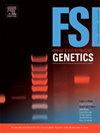关于低覆盖率测序的法医似然比
IF 3.1
2区 医学
Q2 GENETICS & HEREDITY
引用次数: 0
摘要
测序技术的进步使法医科学家能够从越来越具有挑战性的样本中获取遗传信息。最近发表的一种计算方法IBDGem分析了测序读数,包括来自低覆盖率样本的测序读数,以得出人类鉴定的似然比。在这里,我们表明,由IBDGem产生的似然比最好被解释为检验与法医遗传学背景中使用的传统假设不同的零假设。特别是,IBDGem测试了一个假设,即样本来自用于运行该方法的参考数据库中包含的个人。这种零假设通常不符合法医的兴趣,因为辩护假设通常不是证据来自参考数据库中包含的个人。此外,计算出的似然比可能比更标准的法医零假设计算出的似然比要大得多,通常高出许多个数量级,因此可能会产生一种印象,认为身份的证据比保证的证据更有力。我们列出了这个结果,并用实例和仿真来说明它。作为一个示例,在假设测序错误率为零的病理情况下,如果获得的读取显示与参考数据库的每个成员至少有一次不一致,则似然比需要除以零。我们给出了可能导致测试典型防御假设的可能性比的方向建议。本文章由计算机程序翻译,如有差异,请以英文原文为准。
On forensic likelihood ratios from low-coverage sequencing
Advances in sequencing technology are allowing forensic scientists to access genetic information from increasingly challenging samples. A recently published computational approach, IBDGem, analyzes sequencing reads, including from low-coverage samples, in order to arrive at likelihood ratios for human identification. Here, we show that likelihood ratios produced by IBDGem are best interpreted as testing a null hypothesis different from the traditional one used in a forensic genetics context. In particular, IBDGem tests the hypothesis that the sample comes from an individual who is included in the reference database used to run the method. This null hypothesis is not generally of forensic interest, because the defense hypothesis is not typically that the evidence comes from an individual included in a reference database. Moreover, the computed likelihood ratios can be much larger than likelihood ratios computed for the more standard forensic null hypothesis, often by many orders of magnitude, thus potentially creating an impression of stronger evidence for identity than is warranted. We lay out this result and illustrate it with examples and simulations. As one illustrative example, in a pathological case in which the sequencing error rate is assumed to be zero, if the obtained reads display at least one inconsistency with each member of the reference database, then the likelihood ratio entails a division by zero. We give suggestions for directions that might lead to likelihood ratios that test the typical defense hypothesis.
求助全文
通过发布文献求助,成功后即可免费获取论文全文。
去求助
来源期刊
CiteScore
7.50
自引率
32.30%
发文量
132
审稿时长
11.3 weeks
期刊介绍:
Forensic Science International: Genetics is the premier journal in the field of Forensic Genetics. This branch of Forensic Science can be defined as the application of genetics to human and non-human material (in the sense of a science with the purpose of studying inherited characteristics for the analysis of inter- and intra-specific variations in populations) for the resolution of legal conflicts.
The scope of the journal includes:
Forensic applications of human polymorphism.
Testing of paternity and other family relationships, immigration cases, typing of biological stains and tissues from criminal casework, identification of human remains by DNA testing methodologies.
Description of human polymorphisms of forensic interest, with special interest in DNA polymorphisms.
Autosomal DNA polymorphisms, mini- and microsatellites (or short tandem repeats, STRs), single nucleotide polymorphisms (SNPs), X and Y chromosome polymorphisms, mtDNA polymorphisms, and any other type of DNA variation with potential forensic applications.
Non-human DNA polymorphisms for crime scene investigation.
Population genetics of human polymorphisms of forensic interest.
Population data, especially from DNA polymorphisms of interest for the solution of forensic problems.
DNA typing methodologies and strategies.
Biostatistical methods in forensic genetics.
Evaluation of DNA evidence in forensic problems (such as paternity or immigration cases, criminal casework, identification), classical and new statistical approaches.
Standards in forensic genetics.
Recommendations of regulatory bodies concerning methods, markers, interpretation or strategies or proposals for procedural or technical standards.
Quality control.
Quality control and quality assurance strategies, proficiency testing for DNA typing methodologies.
Criminal DNA databases.
Technical, legal and statistical issues.
General ethical and legal issues related to forensic genetics.

 求助内容:
求助内容: 应助结果提醒方式:
应助结果提醒方式:


